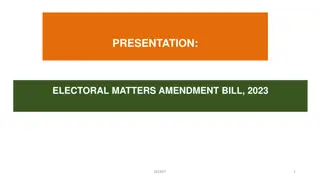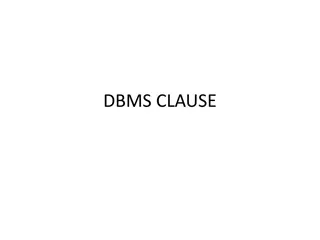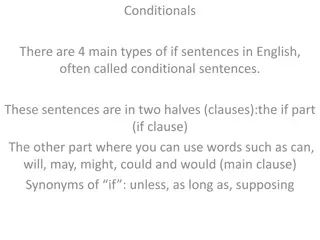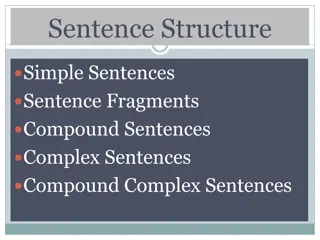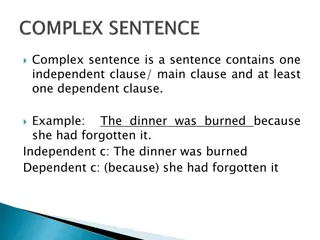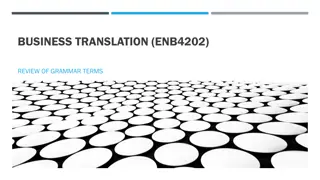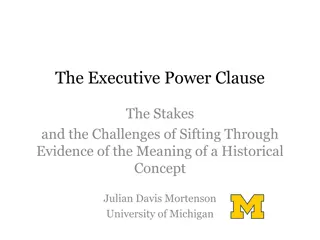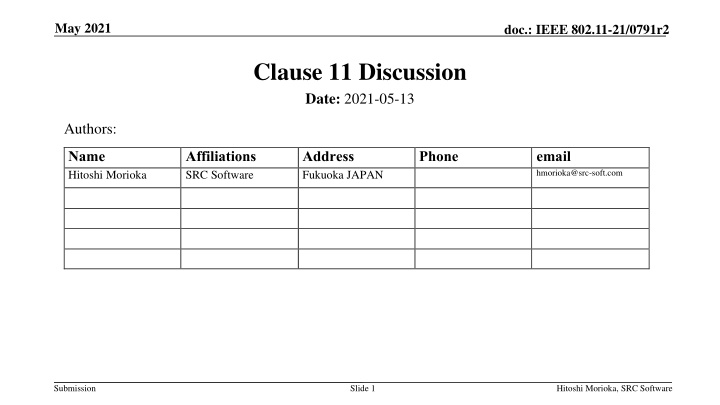
IEEE 802.11-21/0791r2 Clause 11 Discussion
Explore the discussion items and proposed changes in Clause 11 of IEEE 802.11-21/0791r2, focusing on architecture, eBCS operations, and frame types. This presentation addresses the resolution preparation for Clause 11, highlighting key points for further review and development.
Uploaded on | 1 Views
Download Presentation

Please find below an Image/Link to download the presentation.
The content on the website is provided AS IS for your information and personal use only. It may not be sold, licensed, or shared on other websites without obtaining consent from the author. If you encounter any issues during the download, it is possible that the publisher has removed the file from their server.
You are allowed to download the files provided on this website for personal or commercial use, subject to the condition that they are used lawfully. All files are the property of their respective owners.
The content on the website is provided AS IS for your information and personal use only. It may not be sold, licensed, or shared on other websites without obtaining consent from the author.
E N D
Presentation Transcript
May 2021 doc.: IEEE 802.11-21/0791r2 Clause 11 Discussion Date: 2021-05-13 Authors: Name Hitoshi Morioka Affiliations SRC Software Address Fukuoka JAPAN Phone email hmorioka@src-soft.com Submission Slide 1 Hitoshi Morioka, SRC Software
May 2021 doc.: IEEE 802.11-21/0791r2 Abstract This presentation describes discussion items to prepare resolutions for Clause 11. Submission Slide 2 Hitoshi Morioka, SRC Software
May 2021 doc.: IEEE 802.11-21/0791r2 Architecture description CID Comment Proposed Change 1409 Rgw The architecture for this feature is incomplete (making this draft really difficult to review). For eBCS procedures, some component of the MAC needs to manage these services and provide a protocol endpoint for setup, security and data transfer. Please define this component. Define a logical component in the AP (and possibly the STA) that acts as the eBCS service instance. It would encapsulate the broadcast traffic streams in eBCS frames, maintain the state of eBCS broadcasts, and on the AP side, forward or receive frames from the broadcast source or destnation in the network. Describe architecture in 11.100.2.1 for DL and in 11.100.3.1 for UL. Clause 4.5.x Submission Slide 3 Hitoshi Morioka, SRC Software
May 2021 doc.: IEEE 802.11-21/0791r2 S1G and DMG CID Comment Proposed Change 1203 Why would eBCS not be allowed in S1G? Replace "eBCS is only supported in a non-DMG non-S1G infrastructure BSS" with "eBCS is only supported in a non-DMG infrastructure BSS". 1470 The sentence states that eBCS is not supported for 60 GHz and sub 1 GHZ operation. Why not? Delete the cited sentence. New text needs to be added to the draft to describe eBCS operation in both the 60 GHz and sub 1 GHz bands. 1628 "This subclause describes eBCS procedures that are used for eBCS STAs. eBCS is only supported in a non-DMG non-S1G infrastructure BSS." Not sure why S1G infrastructure BSS cannot support eBCS feature. Remove the "non-S1G" EBCS is only supported in a non-DMG non-S1G infrastructure BSS. S1G: For sensor use case? DMG: DMG is directional . It is not suitable for broadcast. check excluding any PHY mode check specific wording Submission Slide 4 Hitoshi Morioka, SRC Software
May 2021 doc.: IEEE 802.11-21/0791r2 OCB or Public Action frame CID Comment Proposed Change 1412 Its not clear to me why eBCS DL procedures use data frames but eBCS UL procedures use action frames. Given that these frames originate and terminate at the AP and never are bridged to the LAN, it would make more sense to define an Action frame that could be used for either UL or DL. This would also make security protocols easier to define. Define both uplink and downlink to use the eBCS frame (given that this information is proxied by an AP anyway. If the use of data frames is absolutely necessary, the 802.11 stnadard defines OCB operations which accomplish this task. 1415 If the AP is sending data frames, how is this different from OCB? The AP? If eBCS DL uses data frames, if they are part of the BSS they would be no different from other data frames. If they are not part of the BSS, they should be defined as OCB frames. TGbc discussed about the frame type for DL data transfer in Jan. 2019 meeting. Minutes: 11-19/2114r0 10. Discussion on frames used for eBCS data 10.1. Straw poll results run during the face to face meeting seems to indicate that the TGbc group wants to: 10.1.1. Use data frames for eBCS data 10.1.2. In the UL case, eBCS data may be piggy-backed in eBCS Info frame (public action frame) Submission Slide 5 Hitoshi Morioka, SRC Software
May 2021 doc.: IEEE 802.11-21/0791r2 Multiple APs CID Comment Proposed Change 1002 An eBCS receiver may be in range of more than one eBCS APs that provides a particular service that the receiver is interested in. The spec must provide guidance on how the receiver can seamlessly move between APs without causing service disruptions or perform duplicate detection when in range of more than one AP providing the same service. 1003 When more than one eBCS APs in the neighborhood provides the same service, are the transnmissions coordinated? I suppose not, each AP can transmit independently. Spec should guidance so that the behavior is When more than one eBCS APs in the neighborhood provides the same service, are the transmissions coordinated? I suppose not, each AP can transmit independently. Spec should guidance so that the behavior is deterministic to the receivers As in comment 1004 An eBCS receiver may move out of range for an eBCS AP from which it is currently receiving broadcast service. The spec must provide guidance on how a receiver can seamlessly move between APs without causing service disruptions. The EBCS receiver can use the same content stream from multiple APs. e.g. AP advertises the BSSID of the neighbor AP(s) in the Content Information in the EBCS Info frame for each content. Neighbor AP: AP that is potentially in the range of the receiver. Duplicate detection has to be provided by higher layer protocol. Although the APs are expected to be operated on the same channel, different channel can be used. Server IP multicast AP AP EBCS Non-AP Submission Slide 7 Hitoshi Morioka, SRC Software
May 2021 doc.: IEEE 802.11-21/0791r2 Complemental Use of Multiple APs Server Content A IP multicast MAC address xx:xx:xx:xx:xx:xx MAC address yy:yy:yy:yy:yy:yy MAC address zz:zz:zz:zz:zz:zz AP1 AP2 AP3 EBCS Info EBCS Info EBCS Info Content A Content A Content A Neighbor List yy:yy:yy:yy:yy:yy Neighbor List yy:yy:yy:yy:yy:yy Neighbor List xx:xx:xx:xx:xx:xx zz:zz:zz:zz:zz:zz Non-AP Duplicate detection shall be provided by the HLP. Submission Slide 8 Hitoshi Morioka, SRC Software
May 2021 doc.: IEEE 802.11-21/0791r2 TIM CID Comment Proposed Change 1005 What is the RA field of an eBCS Data frame set to? If it is set to broadcast address, it means that all STAs including legacy (non-eBCS) STAs would attempt to parse the frame. This can have a power impact on the STAs. It may also confuse legacy STAs when they see broadcast Data frames from its associated AP during non-DTIM intervals. As in comment Modify not to use the Traffic Indicator in the TIM element for the EBCS Data frames (RA: Group address but not broadcast). (EBCS Info frame uses the Traffic Indicator in the TIM element.) And Make EBCS TIM element (similar to the TIM element) for the EBCS Data frames. EID Len Bitmap of Content ID Submission Slide 9 Hitoshi Morioka, SRC Software
May 2021 doc.: IEEE 802.11-21/0791r2 EBCS DL AP Receiver Server IPv4 Multicast (RFC1112) IPv6 Multicast (RFC2464) Dst MAC 01:00:5e:xx:xx:xx RA 01:00:5e:xx:xx:xx 33:33:xx:xx:xx:xx 33:33:xx:xx:xx:xx If the combination of the source IP address, the destination IP address and the destination UDP port of the packet is in the dot11EBCSContentList, the AP uses EBCS to forward the frames. Otherwise, the AP uses GTKSA to forward the frames. (If associated STA exists) In the current standard, the Traffic Indicator field is set to 1 when one or more group addressed MSDUs/MMPDUs are buffered at the AP. Existing non-AP STA decides to wait the group addressed traffic by this bit. EID Len DTIM Count DTIM Period Bitmap Control Partial Virtual Bitmap TIM element Traffic Indicator Bitmap Offset 1bit My proposal: Modify not to use the Traffic Indicator in the TIM element for the EBCS Data frames And Make EBCS TIM element (similar to the TIM element) for the EBCS Data frames. EID Len Content ID Bitmap (new) EBCS TIM element Submission Slide 10 Hitoshi Morioka, SRC Software


